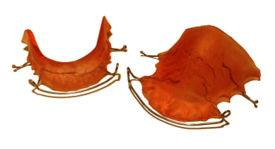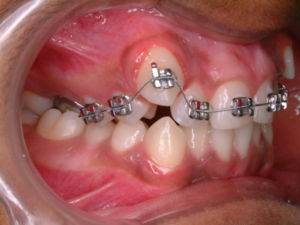Our Welcoming Reception & 1st Waiting Area
Our Ground Floor Operatory
Our Ground Floor Operatory
Our Laboratory
Our Display Area With Updated Oral Hygiene Measures
Our First Floor Operatory
Our First Floor Operatory
Correction of Crowding
FREQUENTLY ASKED QUESTION
- Q: What is orthodontics?
- Q: Why is orthodontics important?
- Q: What are the benefits of braces?
- Q: At what age should orthodontic treatment occur?
- Q: What is a malocclusion?
- Q: What are some early warning signs of a bite problem?
- Q: Will braces hurt?
- Q: What can I eat with braces?
- Q: Why do baby teeth sometimes need to be pulled?
- Q: What about the wisdom teeth (third molars), should they be removed?
- Q: How long will I have to undergo orthodontic treatment?
- Q: Can you be too old for braces?
- Q: Why are retainers needed after orthodontic treatment?
- Q: Is orthodontic care expensive?
- Q: How often will I need office visits?
Still have questions?
Ask us for more information.
Q: What is orthodontics?
A: Orthodontics is a specialty of dentistry that is concerned with the study and treatment of malocclusions (improper bites), which may be a result of tooth irregularity, disproportionate jaw relationships, or both. The word comes from the Greek words ortho meaning straight and odons meaning tooth.
Orthodontic treatment can focus on dental displacement only, or can deal with the control and modification of facial growth. In the latter case it is better defined as "dentofacial orthopedics". Orthodontic treatment can be carried out for purely aesthetic reasons—improving the general appearance of patients' teeth and face for cosmetic reasons—but treatment is often prescribed for practical reasons, providing the patient with a functionally improved bite (occlusion). And Rai Dental Clinic is having Dr Siddarth Shetty to think best treatment for your child.
Q: Why is orthodontics important?
A: An attractive smile and improved self-image is just one of the benefits of orthodontic treatment. Without treatment, orthodontic problems can lead to tooth decay, gum disease, bone destruction, chewing and digestive difficulties, speech impairments, tooth loss and other dental injuries.
Q: What are the benefits of braces?

A: Having straight teeth that fit together properly improves function and your teeth and jaw joints can work more effectively. Straight teeth make it easier for you and your dental team to keep them clean. If you ever need a filling, crown or bridge, your dentist can usually do better restoration if the teeth are aligned properly. The appearance of teeth and face is improved. Having a pleasing smile improves self-esteem, confidence and a feeling of acceptance in our daily activities.
Q: At what age should orthodontic treatment occur?
A: Orthodontic treatment can be started at any age. Many orthodontic problems are easier to correct if detected at an early age before jaw growth has slowed. Early treatment may mean that a patient can avoid surgery and more serious complications. The American Association of Orthodontists recommends that every child first visit an orthodontist by age 7 or earlier if a problem is detected by parents, the family dentist or the child's physician.
Q: What is a malocclusion?
A: Malocclusion literally means bad bite. Most malocclusions are inherited, however, it is possible to acquire a bad bite from habits such as tongue thrusting and thumb sucking. The premature loss of baby teeth or the extraction of adult teeth can also cause the development of malocclusion.
Q: What are some early warning signs of a bite problem?
A: Early or late loss of primary teeth, Difficulty in chewing or biting, Mouth breathing, Finger sucking or other oral habits beyond age 5, Overlapped, misplaced or blocked-out teeth, Protruding teeth, Biting the cheek or into the roof of the mouth, Teeth that meet in an abnormal manner or do not meet at all, Jaws that shift or make sounds, Jaws that protrude, retrude or contribute to facial imbalance, Speech difficulty.
Q: Will braces hurt?
A: Most patients experience some discomfort the first week after their braces are put on and immediately after their braces are tightened. Aspirin, non-aspirin pain reliever or ibuprofen can be used to ease the discomfort.
Q: What can I eat with braces?
A: Most foods can be enjoyed just as before you got your braces. Hard, crunchy and sticky foods can damage braces and should be avoided.
Q: Why do baby teeth sometimes need to be pulled?
A: Pulling baby teeth may be necessary to allow severely crowded permanent teeth to come in at a normal time in a normal location. If the teeth are severely crowded, some permanent teeth will either remain impacted (teeth that should have come in, but have not), or come in to an undesirable position. To allow severely crowded teeth to move on their own into much more desirable positions, sequential removal of baby teeth and permanent teeth (usually first premolars) can dramatically improve a severe crowding problem. This sequential extraction of teeth, called serial extraction, is typically followed by comprehensive orthodontic treatment after tooth eruption has improved as much as it can on its own.
Q: What about the wisdom teeth (third molars), should they be removed?
A: In about three out of four cases where teeth have not been removed during orthodontic treatment, there are good reasons to have the wisdom teeth removed, usually when a person reaches his or her mid- to late- teen years. Your orthodontist, in consultation with your family dentist, can determine what is right for you.
Q: How long will I have to undergo orthodontic treatment?
A: It will vary for each patient and always depends on how much your jaw needs to change and how far your teeth must move. Early treatment usually lasts from 6-12 months. Full treatment with full braces will last from 18-36 months. Average time is 24 months.
Q: Can you be too old for braces?
A: No. Age is not a factor, however, there are advantages to treating young people while they are still growing. About 25% of orthodontic patients in the United States are adults. If you are an adult considering orthodontic work, that treatment has changed a great deal in the last few years. Braces are more comfortable and more effective today. You can get braces in the tradition silver color, or with much less visible clear brackets.
Q: Why are retainers needed after orthodontic treatment?

A: After braces are removed, teeth can shift out of position if they are not stabilized. Retainers provide that stabilization and are designed to hold teeth in their corrected, ideal positions until the bones and gums adapt to the treatment changes. Wearing retainers exactly as instructed is the best insurance that the treatment improvements last for a lifetime.
Q: Is orthodontic care expensive?
A: Orthodontic fees have not increased as fast as many other consumer products. When orthodontic treatment is implemented at the proper time, treatment is often less costly than the dental care required to treat the more serious problems that can develop years later. After examining you or your child, we will review the costs involved with treatment. Financing is usually available and our office offers customized-flexible payment programs that will meet your needs. In addition, many insurance plans now include orthodontics.
Q: How often will I need office visits?
A: Once appliances are in place, routine office visits are at six-to-eight week intervals. Periodically, we may need to see you sooner or in case of any emergency we will probably need to see you that day.
CASES REPORT

Orthodontic treatment of crowded teeth; the canine is being pulled down into proper position with highly flexible co-axial wire

After 10 months of fixed orthodontic treatment. Further treatment is necessary to correct the bite.
Click Here To See Photo Gallery : Correction Crowding Teeth
